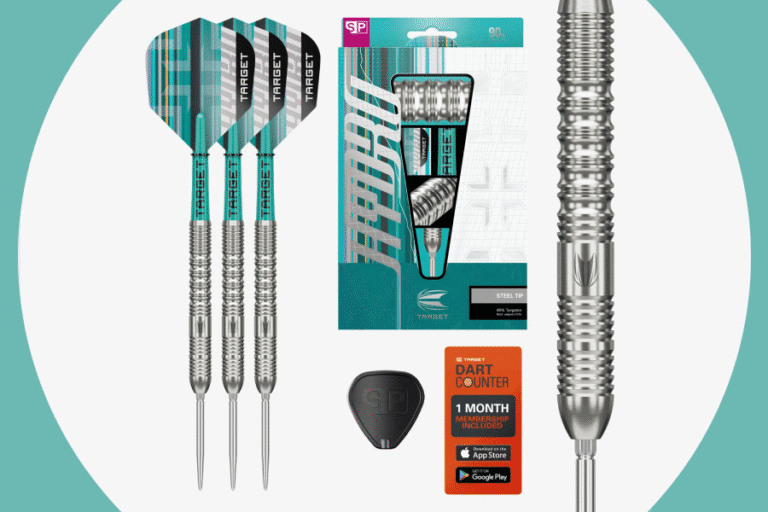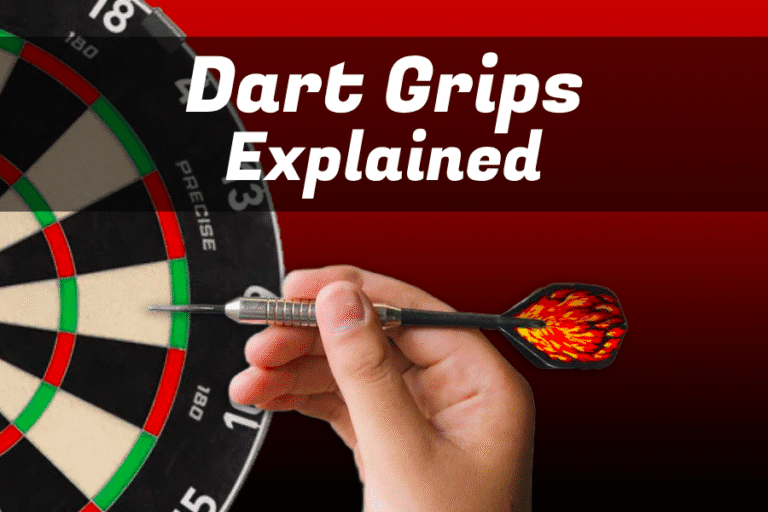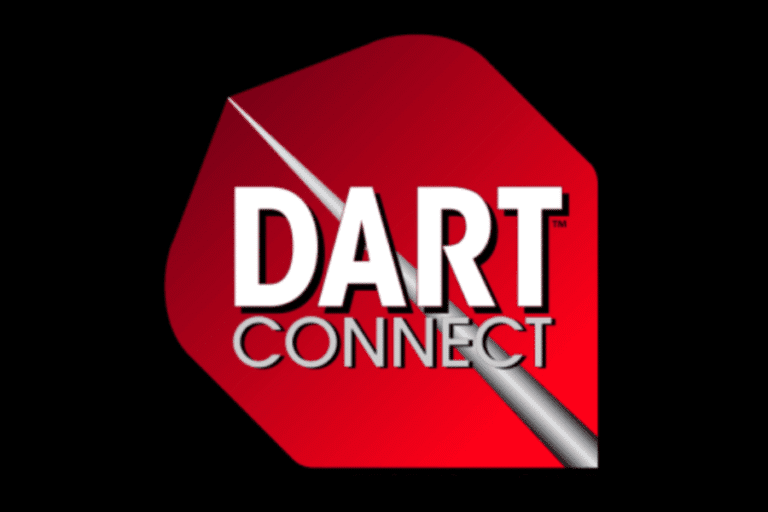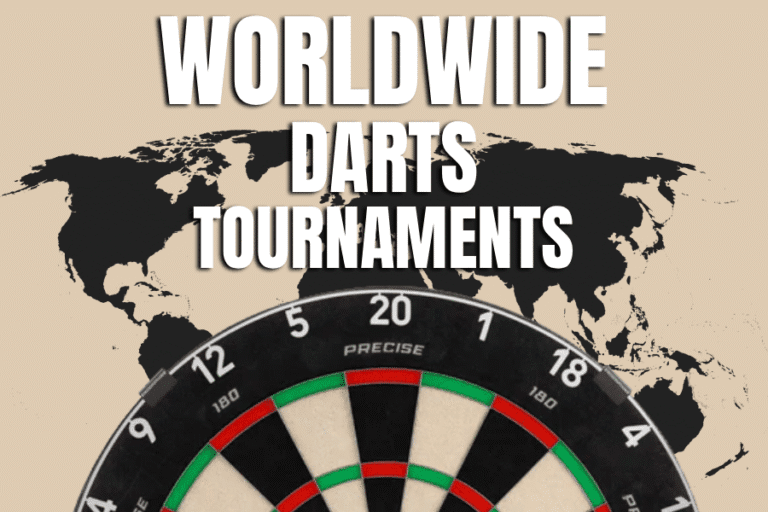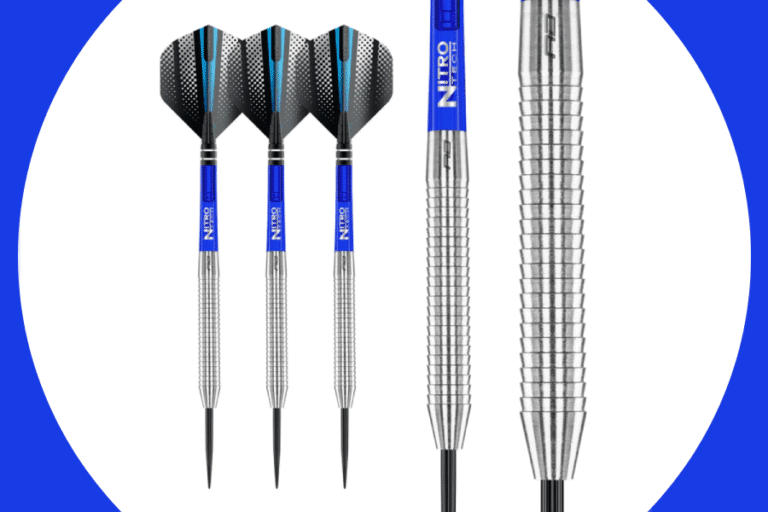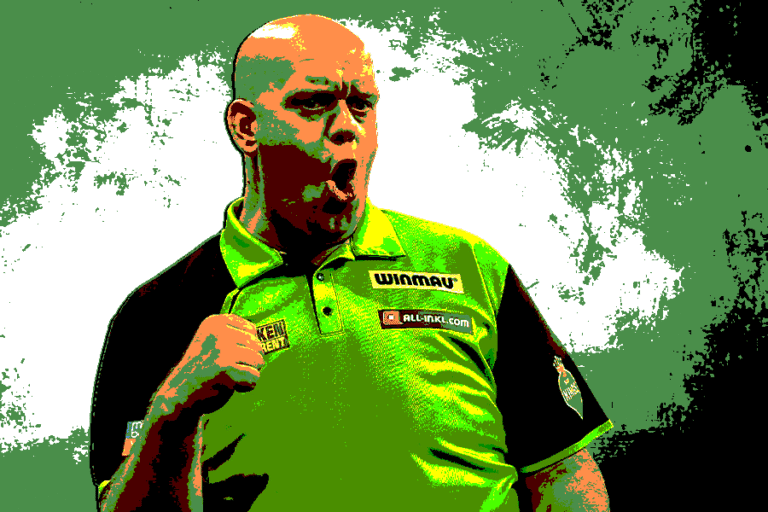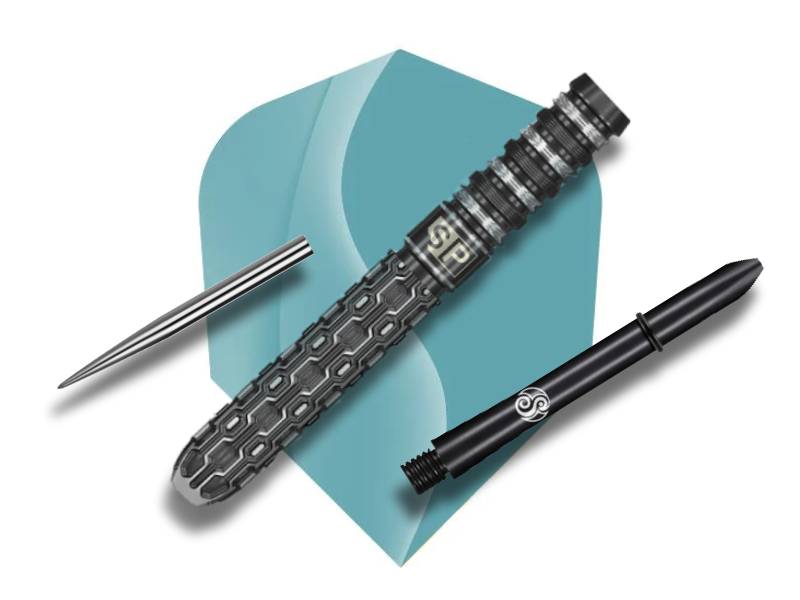
Finding the perfect darts involves more than just choosing individual components; it’s about achieving harmony between them. Every element—barrel, shaft, flight, and tip—needs to work together seamlessly to enhance your throwing style and performance.
Understanding how each component affects the dart’s overall feel and flight can transform your game from inconsistent to exceptional.
In this guide, we’ll explore how to select and combine these elements to create a dart setup that feels natural and effective.

Types of Dart Barrels: Materials and Shapes
Selecting the right dart barrel is crucial for optimizing your performance. The material and shape of the barrel influence your grip, control, and overall gameplay. Here’s a detailed look at the various barrel materials and shapes to help you in the process of making an informed choice.
Dart Barrel Materials
Tungsten
- Tungsten is a favored material for dart barrels due to its density and durability. Its high density allows for slimmer barrels without sacrificing weight, leading to better aerodynamics and control. A higher tungsten content means a slimmer barrel, which enhances flight stability and accuracy. However, tungsten darts can be more expensive, and some players might find them slightly harder compared to softer materials.
Nickel-Silver
- Nickel-silver barrels are a more budget-friendly option. Made from a mix of nickel and silver, they offer a balance of weight and durability at a lower price. These barrels are often chosen by beginners due to their affordability and decent performance. While they are less durable than tungsten and generally lighter, they provide a good balance of grip and control for the cost.
Stainless Steel
- Stainless steel barrels provide a blend of weight and durability. Commonly found in mid-range darts, stainless steel is resistant to rust and corrosion. It offers a balanced feel and control, making it a reliable option for many players. While not as dense as tungsten, stainless steel barrels are generally more affordable and provide good performance for their price range.
Alloy
- Alloy barrels are composed of various metals, including nickel and copper, to balance weight and durability. This mixture aims to offer a combination of features from different metals, providing a versatile option. Alloy barrels are often positioned in the mid-range price bracket, offering a balance of weight and durability. However, the performance can vary depending on the specific alloy composition.
Brass
- Brass is a popular material for dart barrels, especially among beginners and casual players. It is an affordable option, offering decent durability and a relatively lightweight feel. Brass barrels are often thicker due to the material’s lower density, which can provide a comfortable grip for those who prefer a bulkier dart. However, brass is softer than more advanced materials like tungsten, so it tends to wear down more quickly with frequent use.
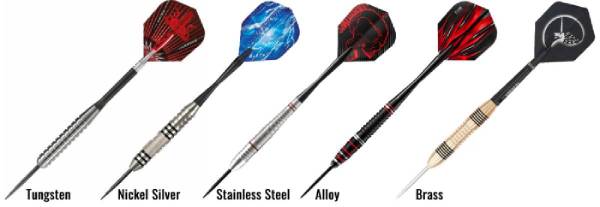
Barrel Shapes: Finding the Right Fit for Your Throw
The shape of the dart barrel is a key factor that influences how the dart feels in your hand, as well as how it flies through the air. Different barrel shapes provide varying levels of balance, control, and comfort. Choosing the right shape for your grip and throwing style can make a significant difference in your accuracy and consistency. Let’s explore the most common barrel shapes and how they impact your game.
Straight Barrels: Consistent and Balanced
Straight barrels are the most common shape and are popular among players of all skill levels. As the name suggests, these barrels have a uniform width from the front to the back, offering a consistent grip and weight distribution.

Impact on Flight:
Because the weight is evenly distributed, straight barrels provide a balanced flight path. This makes them a reliable choice for players who prefer consistency and precision. Whether you grip the dart near the front, middle, or back, the uniformity of the barrel ensures that the dart remains stable in flight.
Ideal for:
- Players who want a balanced and predictable flight
- Beginners who are still developing their throwing technique
- Players with varied grip positions
Tapered Barrels: Focused Front-Weight
Tapered barrels widen toward the front of the dart, creating a front-weighted feel. This shape is designed to concentrate more mass toward the tip, making the dart easier to guide toward the target with a controlled, forward motion.

Impact on Flight:
The front-weighted nature of tapered barrels helps create a more direct, downward flight path. The extra weight at the front allows for smoother throws and better penetration on the dartboard.
These barrels tend to suit players who prefer to grip the dart near the back and push it toward the board with precision.
Ideal for:
- Players who prefer front-weighted darts
- Those who grip the dart near the back of the barrel
- Players who want more control over the dart’s direction
Torpedo Barrels: Front-Weighted for Power
Torpedo-shaped barrels are thicker in the middle and taper toward both ends, resembling a torpedo. This design creates a front-heavy dart that provides a solid feel in the hand and helps players generate more power in their throws.

Impact on Flight:
Due to the extra weight near the front, torpedo-shaped barrels tend to fly straight and maintain a steady downward trajectory. They are excellent for players who like to throw with force but still want precision. The thicker middle offers a comfortable grip, particularly for players with larger hands.
Ideal for:
- Players who want a combination of power and control
- Those who prefer a front-weighted feel with a thicker grip
- Players who grip the middle or rear of the dart
Scalloped Barrels: Ergonomic Grip for Better Control
Scalloped barrels feature indentations along the length of the barrel, providing natural finger grips for improved control. These indents help players maintain a consistent grip position during each throw, which is especially useful for players who struggle with grip consistency.

Impact on Flight:
The scalloped design ensures a secure hold on the dart, preventing it from slipping during release. This increased control helps produce a smoother flight trajectory and greater accuracy. The design encourages a stable, direct flight path, making it easier for players to replicate the same throw each time.
Ideal for:
- Players who need better grip control
- Players who value consistency in their release
- Those who want added stability in their throws
Bomb Barrels: Compact and Front-Heavy
Bomb-shaped barrels are short and thick, with a rounded, compact design that places most of the weight near the front. These barrels are usually shorter than other shapes, making them ideal for players who prefer a quick, powerful release.

Impact on Flight:
Due to their compact nature and front-weighted design, bomb barrels produce a direct and fast flight trajectory. The heavy front end helps the dart maintain its momentum toward the board, making it an excellent choice for players who throw with more power.
The thicker design provides a comfortable grip, especially for players with larger hands or those who prefer a heavier dart.
Ideal for:
- Players who prefer shorter, heavier darts
- Those with a fast, powerful throw
- Players who grip closer to the front of the dart
How Barrel Shape Impacts Your Game
Each barrel shape offers a unique combination of weight distribution, grip, and flight characteristics. Finding the right shape for you depends on your playing style, grip preference, and desired level of control. Whether you prefer the balanced feel of a straight barrel, the power of a torpedo, or the control of a scalloped design, experimenting with different shapes can help you discover what works best for your game.
Understanding Dart Weight: What’s Best for Your Throwing Style?
Light Darts (14–19 Grams): Precision for Skilled Players
Lighter darts require more force to throw but offer better precision. Skilled players who have developed a consistent throwing technique often prefer lighter darts. The reduced weight allows for finer control over the dart’s path, but it demands more effort to achieve the same penetration as heavier darts.
If you’re confident in your ability to control your throw, a lighter dart could improve your accuracy. However, lighter darts can be more challenging to master because even minor inconsistencies in your throw are more noticeable.

Stephen Bunting’s unique style sets him apart on the PDC circuit. Formerly using a 12g barrel, a rarity among professionals, ‘The Bullet’ made a successful transition to 18-gram darts, resulting in a significant improvement in his game.
Medium-Weight Darts (19–24 Grams): The Balanced Option
Medium-weight darts are the most versatile option. These darts strike a balance between control and power, making them ideal for most players.
For beginners, medium-weight darts are forgiving and easy to handle. Experienced players often favor them for their adaptability in different playing conditions. The 19–24-gram range provides just enough heft to ensure the dart penetrates the board with ease while still allowing you to fine-tune your throws. This weight range also provides versatility, as it’s suitable for various grip and release styles.
Heavy Darts (25–40 Grams): Power Without Effort
Heavier darts are easier to throw with minimal effort. They require less force to reach the board, making them ideal for players who prefer a slower, more relaxed throwing style. The added weight can also provide more stability in the air, making it easier to maintain a consistent trajectory.
However, the extra weight of these darts can also lead to less control. Heavier darts may be less forgiving when it comes to accuracy, especially for players with inconsistent throws. Players who prefer power over precision will benefit the most from heavier darts.

Jules van Dongen, known as the Dutch Dragon, has made a name for himself in the darts world with his distinctive style and impressive skills. Armed with a set of 25g Winmau Signature darts, van Dongen exemplifies precision and power in every throw.
Barrel Weight Distribution: Front, Middle, and Rear
Barrel weight distribution plays a critical role in how your dart behaves in flight. Whether the weight is concentrated in the front, middle, or rear, each has its own impact on balance and flight trajectory. Let’s dive deeper into how these weight distributions affect your throw.
Front-Weighted Darts: Enhanced Control and Precision
Front-weighted darts have most of their mass concentrated toward the tip. This setup provides a forward-heavy feel, ideal for players who prefer to push the dart toward the board in a controlled and deliberate manner.
Flight Trajectory:
With the extra weight at the front, the dart naturally points downward as it flies through the air. This produces a smoother, more predictable arc. Players who prioritize precision and accuracy often gravitate toward front-weighted darts. Because of the forward mass, these darts penetrate the board more effectively, even at slower throwing speeds.
Ideal for:
- Players with a slower, more controlled throw
- Players who focus on precision over speed
- Beginners looking for predictability in flight
Middle-Weighted Darts: Balanced and Adaptable
Middle-weighted darts offer an even distribution of mass across the barrel, creating a balanced dart that can suit a variety of playing styles. This versatility makes middle-weighted darts a favorite for both beginners and experienced players.
Flight Trajectory:
The even weight distribution ensures a straight, consistent flight path, making the dart easier to control regardless of your throwing style. This balance also means the dart’s flight is forgiving, as minor inconsistencies in your throw will have less of an impact on the trajectory. Middle-weighted darts work well with various shaft lengths and flight shapes, allowing you to customize your setup without drastically changing the dart’s performance.
Ideal for:
- Players seeking a versatile, adaptable dart
- Beginners looking for a forgiving setup
- Players who like to experiment with different grip styles
Rear-Weighted Darts: Power and Speed
Rear-weighted darts concentrate most of their mass toward the back of the barrel. This creates a back-heavy feel, ideal for players who throw with more power and speed.
Flight Trajectory:
Darts with rear-heavy weight distribution tend to follow a more curved flight path. The added weight at the back gives the dart more momentum, allowing it to cut through the air faster. This extra speed, however, can make the dart harder to control, especially for players with less consistent throws. If you’re someone who naturally throws with a lot of force, a rear-weighted dart can help maximize your power while still maintaining accuracy.
Ideal for:
- Players with a fast, powerful throwing style
- Players who prefer speed over precision
- Experienced players who want more momentum and force behind their throws
Experimental Observation
A comprehensive dart throwing trial was conducted to analyze typical dart flight patterns at Sheffield Hallam University in England. The trial involved 19 participants who volunteered and took part in the experiment. A summary of the findings was as follows:

- The dart is released with a downward pitch and a nose-down rotation. The mismatch between the pitch angle and flight path causes aerodynamic forces at the dart’s rear, leading to a pitching moment and angular deceleration.
- As the pitch angle quickly drops to zero, the dart maintains its nose-down rotation due to angular momentum. This creates a negative angle of attack, resulting in positive (nose-up) angular acceleration.
- The positive angular acceleration counters the negative angular velocity, gradually transitioning the dart to a positive angular velocity.
- At the peak of its trajectory, the dart’s pitch angle, flight path angle, and angle of attack all approach zero.
- During the descent, the dart retains its positive angular velocity due to angular momentum, resulting in a positive angle of attack that causes negative angular acceleration and slows the dart’s positive angular velocity to zero.
- Near the scoring bed, the dart’s positive angle of attack keeps the negative angular acceleration, leading to a negative angular velocity. This results in a small negative pitch angle at landing, which may obstruct visibility and complicate stacking.
Grip Profiles: For Precision and Control
Choosing the right dart barrel goes beyond just material or shape; the grip profile is equally important. The grip profile determines how comfortably and securely you can hold the dart, directly impacting your accuracy and control. Understanding the different types of dart barrel grip profiles will help you select a dart that aligns with your throwing style and enhances your overall game.
Smooth Grip
Smooth grip is the most basic option, featuring a completely smooth surface. This profile offers minimal resistance, allowing the dart to glide easily out of your hand. It’s ideal for players who prefer a quick release and minimal interference during their throw. However, it may not provide enough traction for those who require a firmer grip.

Ringed Grip
Ringed grips are among the most common profiles. These grips consist of evenly spaced rings or grooves around the barrel, offering a balanced level of grip. The ringed design provides enough traction for control while still allowing for a smooth release, making it suitable for a wide range of players, especially those refining their technique.

Knurled Grip
Knurled grips have a textured surface with small, diamond-shaped patterns that provide a high level of grip. This profile makes it easier to hold the dart securely, which is beneficial for players who need extra traction to maintain control. While knurled grips offer excellent grip, some players might find them too aggressive, potentially leading to inconsistent releases.

Shark Grip
Shark grips feature deep, angled grooves that resemble shark teeth, providing an aggressive grip that ensures the dart stays firmly in your hand until release. This profile is perfect for players who require maximum traction, especially in situations where their hands might become sweaty. However, the pronounced grip can take some getting used to and may affect the smoothness of your throw.

Micro Grip
Micro grips, on the other hand, have fine, closely spaced grooves or ridges, offering a subtler texture compared to knurled or shark grips. This profile provides a more delicate level of grip, giving players the sensation of control without the harshness of deeper textures. It’s suitable for players who prefer a softer feel but still want some added traction for precision.

Precision Milled Grip
Precision-milled grips are designed with intricate patterns that are precisely cut into the barrel. These patterns can range from geometric shapes to custom designs, offering both aesthetics and functionality. Precision-milled grips provide a unique feel, combining style with performance, making them ideal for experienced players who want a distinctive and reliable grip.

Shaft Length & Material: What Works for You?
Short Shafts: Better for Front-Weighted Darts
Short shafts create a front-weighted dart, giving you more control over the direction of your throw. They are best suited for players who like faster, more aggressive throws. However, short shafts may reduce the dart’s stability in flight. If you tend to throw quickly and prefer a direct path to the board, short shafts could be the right choice for you. Be prepared to practice more to achieve consistency with short shafts.
Medium Shafts: A Balanced Approach
Medium shafts are the most versatile option, providing a good balance between control and stability. These shafts are popular among players of all skill levels because they work well with different barrel types and throwing styles. If you’re not sure which shaft length to choose, medium shafts are a great starting point. They offer the best of both worlds, giving you flexibility in your throw while maintaining accuracy.
Long Shafts: For Added Stability
Long shafts provide greater stability, making them ideal for players who prefer a slower, more controlled game. These shafts allow the dart to glide more smoothly through the air, making it easier to land consistent throws. Long shafts can also benefit players who grip the dart near the back, as they help maintain balance and prevent the dart from wobbling during flight.

Dart Flight Shapes: How Surface Area & Shape Impact Flight
Dart flights play a crucial role in determining the dart’s stability and trajectory. The shape of the flight, along with its surface area, significantly influences how the dart moves through the air. Choosing the right flight shape can improve your accuracy, control, and overall performance. Each shape has its own benefits, and the shaft length you pair with the flight can further fine-tune your dart’s flight path. Let’s explore the most popular dart flight shapes and how they affect your game.
Standard Flights: Maximum Stability for Slower Throws
Standard No.2 flights are the most common flight shape, characterized by a large surface area (Approximately 39cm²). They are ideal for players who throw their darts at a slower speed and want maximum stability during flight. The larger surface area catches more air, helping to slow the dart down and maintain a steady, straight path.
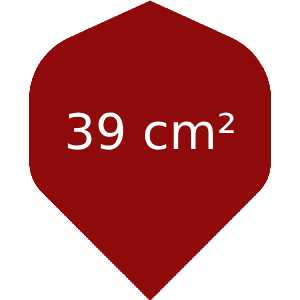
Impact on Flight:
Due to their large size, standard flights create significant drag, which stabilizes the dart during its trajectory. This makes them ideal for players who prefer a slower, more controlled throw. The drag helps the dart glide smoothly through the air and keeps the flight path steady, resulting in better accuracy.
Ideal Shaft Length:
Pair standard flights with medium or long shafts to maintain balance and stability. The longer shaft complements the large surface area of the flight, ensuring the dart stays level in the air.
Ideal for:
- Players who prefer slower, more controlled throws
- Players using heavier darts
- Beginners seeking stability in flight
Shape Flights: Balance of Stability and Speed
Shape flights (No.6) are a scaled-down version of standard flights, offering a balance between stability and speed. They provide enough surface area (Approximately 26 cm²) to keep the dart stable but reduce drag for faster, more direct throws.

Impact on Flight:
The smaller surface area compared to standard flights results in less drag, allowing for a faster and more direct trajectory. Small standard flights are versatile and can suit various throwing styles, offering a balance between control and speed.
Ideal Shaft Length:
Pair No.6 flights with medium shafts to maintain a good balance between control and speed. A medium shaft helps the dart achieve a consistent flight path while allowing for more power.
Ideal for:
- Players who want a balance between speed and control
- Those who prefer lighter darts
- Intermediate players looking to improve accuracy
Pear Flights: Faster Throws with Reduced Drag
Pear-shaped flights have a rounded, teardrop design that reduces surface area (Approximately 30 cm²) compared to standard flights. This shape generates less drag, resulting in a faster flight, making pear flights ideal for players who prefer quick, powerful throws.
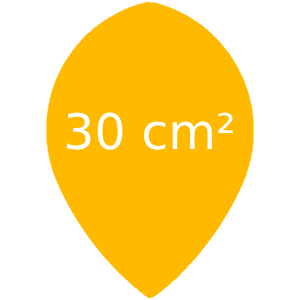
Impact on Flight:
The smaller surface area of pear flights creates less air resistance, allowing the dart to travel more quickly toward the board. This faster flight is well-suited for players who have a faster throwing style and want the dart to reach the board with minimal delay. The reduced drag also provides a more direct trajectory, making these flights a good choice for players who prioritize speed over stability.
Ideal Shaft Length:
Pear flights pair best with short or medium shafts, which help to maintain a quick, direct flight path. The shorter shaft enhances the dart’s speed, complementing the reduced surface area of the flight.
Ideal for:
- Players with fast, aggressive throws
- Those looking to reduce drag and increase dart speed
- Players using lighter, front-weighted darts
Kite Flights: Precision and Control
Kite flights are smaller than standard flights but still provide enough surface area (Approximately 33 cm²) to offer good control and precision. Their unique triangular shape helps reduce drag while maintaining enough stability for a controlled throw.
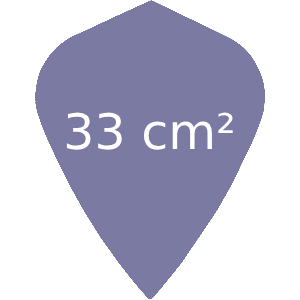
Impact on Flight:
Kite flights strike a balance between speed and control. They offer more precision than standard flights while still providing enough drag to stabilize the dart. This shape is ideal for players who need a little more speed than standard flights can provide but still want control over their throws.
Ideal Shaft Length:
Pair kite flights with medium shafts for the best balance of control and speed. The medium shaft allows the dart to maintain its flight path while giving you enough power to reach the target quickly.
Ideal for:
- Players looking for a balance between control and speed
- Players with a controlled, medium-speed throw
- Those who want more accuracy without sacrificing speed
Slim Flights: Increased Speed and Direct Flight
Slim flights are long and narrow, offering minimal surface area. These flights are designed for players who prioritize speed and directness in their throws. They generate very little drag, allowing the dart to reach the board quickly and with a sharper trajectory.
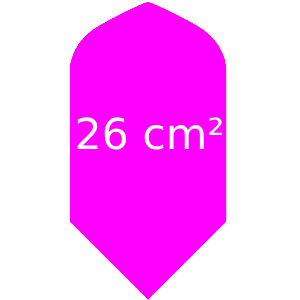
Impact on Flight:
The reduced surface area of slim flights (Approximately 26 cm²) means less air resistance, which allows for faster throws. However, this lack of drag can make the dart less stable, requiring a more precise and consistent throw. Slim flights are ideal for players who use lighter darts and want to cut through the air with minimal drag.
Ideal Shaft Length:
Slim flights pair well with short shafts. The shorter shaft complements the fast, direct nature of the slim flight, allowing the dart to cut through the air with precision and speed.
Ideal for:
- Players using lighter darts
- Those with a fast, direct throwing style
- Advanced players who don’t require as much stabilization
Vortex Flights: High Stability for Slower Throws
Vortex flights are designed to generate maximum drag, providing excellent stability for slower throws. These flights are typically larger, similar to standard flights, but may have unique textures or contours to further increase drag.
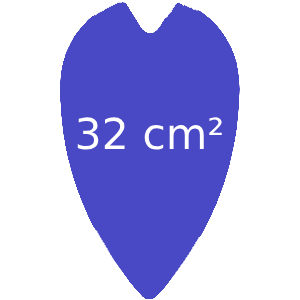
Impact on Flight:
The increased drag provided by vortex flights makes them perfect for players who prioritize control over speed. These flights help stabilize the dart, ensuring that it follows a straight, steady trajectory even when thrown at a slower pace.
Ideal Shaft Length:
Pair vortex flights with long shafts for maximum stability. The combination of a larger flight and a longer shaft helps slow the dart down, giving you more time to aim and control your throw.
Ideal for:
- Players who prefer slower, more controlled throws
- Players using heavier darts
- Beginners or players who struggle with dart stability
Pairing the right flight shape with the appropriate shaft length allows you to fine-tune your dart’s performance. Shorter shafts work best with smaller flights for quicker, more direct throws, while longer shafts complement larger flights for added stability and control.
By experimenting with different flight shapes and shaft lengths, you can find a combination that suits your throwing style and helps you achieve greater accuracy and consistency in your game.
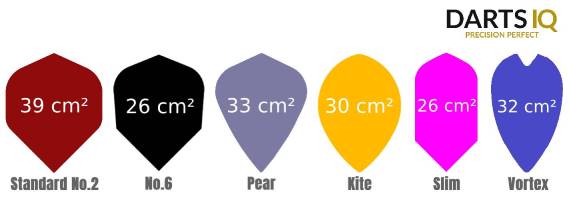
Mastering Your Darts Setup for Consistent Performance
Mastering your darts setup involves creating a seamless connection between you and your darts. When every component—from the barrel to the flight—works in sync with your throwing style, it allows you to play with consistency, confidence, and precision.
Understanding Your Throwing Style
The first step in mastering your darts setup is understanding your unique throwing style. Are you a power thrower, or do you prefer a more controlled, finesse approach? Do you grip the dart near the front, center, or rear of the barrel? Identifying these details helps you choose components that complement your natural tendencies.
Selecting the Right Components
Once you’ve identified your throwing style, you can start selecting components that align with it. Begin with the barrel, as it’s the core of your dart. Choose a shape that fits comfortably in your hand—whether it’s straight, tapered, or torpedo. The grip should be secure but not overly aggressive, allowing for a smooth release.
Next, consider the shaft. The length and material of the shaft influence the dart’s balance and stability. A longer shaft might offer the steady flight you need, while a shorter one could provide the quick, responsive action you prefer. The material—be it aluminum, nylon, or carbon fiber—should contribute to the overall feel and weight distribution of the dart.
The flight is where you fine-tune your dart’s aerodynamics. A standard flight offers stability, while smaller shapes like slim or pear reduce drag for a faster throw. The flight’s material and thickness also affect how the dart moves through the air, so choose one that enhances your desired flight path.
Finally, the tip must work harmoniously with the rest of your dart setup. Steel tips provide durability and precision for traditional boards, while soft tips are designed for electronic boards. Ensure that the weight and length of the tip complement the balance of the dart, completing your overall setup.
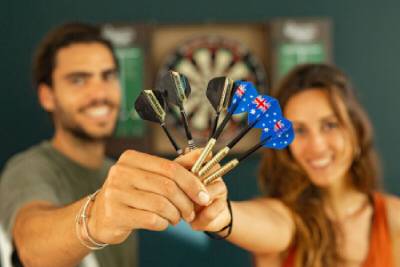
Testing and Refining Your Setup
Mastering your darts setup doesn’t happen overnight. It requires testing and refining. Once you’ve assembled your darts, practice with them to evaluate their performance. Pay attention to how they feel, how they fly, and how consistently you hit your target. If something feels off, make small adjustments—perhaps a different shaft length improves balance, or a heavier flight provides better stability.
Trusting the Process
Mastering your darts setup is a journey. The perfect dart isn’t just about the individual components you choose, but how they work together as a whole. By trusting the process, being patient, and making adjustments based on performance, you’ll gradually refine your setup.
When your setup is perfected, your darts will feel like a natural extension of your hand. Every throw will be consistent, accurate, and effortless, allowing you to focus on the game rather than the mechanics of your throw. This connection between you and your darts is the key to elevating your performance and fully enjoying the game.
Frequently Asked Questions (FAQ’s)
What factors should I consider when choosing a dart barrel?
Consider the barrel material (e.g., tungsten, brass), shape (e.g., straight, torpedo), and grip profile. These factors impact the dart’s weight, balance, and how it feels in your hand.
How does the weight of a dart affect its performance?
Heavier darts are generally more stable in flight and require more force to throw, while lighter darts allow for a faster throw and can be more forgiving in tight groupings.
Which shaft length is best for my playing style?
Short shafts offer better control, medium shafts provide a balanced performance, and long shafts enhance stability. Your choice should complement your grip style and throwing technique.
What’s the difference between different flight shapes?
Standard flights offer stability, slim flights reduce drag for faster throws, and pear-shaped flights provide a balance between speed and control. The choice depends on your desired flight path and throwing style.
Does the material of the shaft make a difference?
Yes, materials like aluminum offer durability and balance, nylon is lightweight and flexible, and carbon fiber provides strength and stability. Choose a material that complements your dart setup.
How do I determine the best grip for my dart barrel?
The best grip depends on your personal preference. A smooth grip allows for easy release, while a textured or knurled grip provides extra hold for those with sweaty hands or who prefer more control.
Should I use steel or soft tips for my darts?
Use steel tips for traditional bristle boards and soft tips for electronic boards. The choice depends on the type of dartboard you’re using and your playing environment.
How do I balance my dart for optimal performance?
Balance your dart by ensuring the weight distribution is even. The center of gravity should be towards the front for a more controlled throw or towards the middle for a balanced flight.
Can I mix and match components from different brands?
Yes, most dart components are interchangeable. Experiment with different combinations to find the setup that works best for your throwing style.
How often should I replace my dart components?
Replace components when you notice wear or damage, such as bent tips, worn flights, or loose shafts. Regularly maintaining your darts ensures consistent performance.

